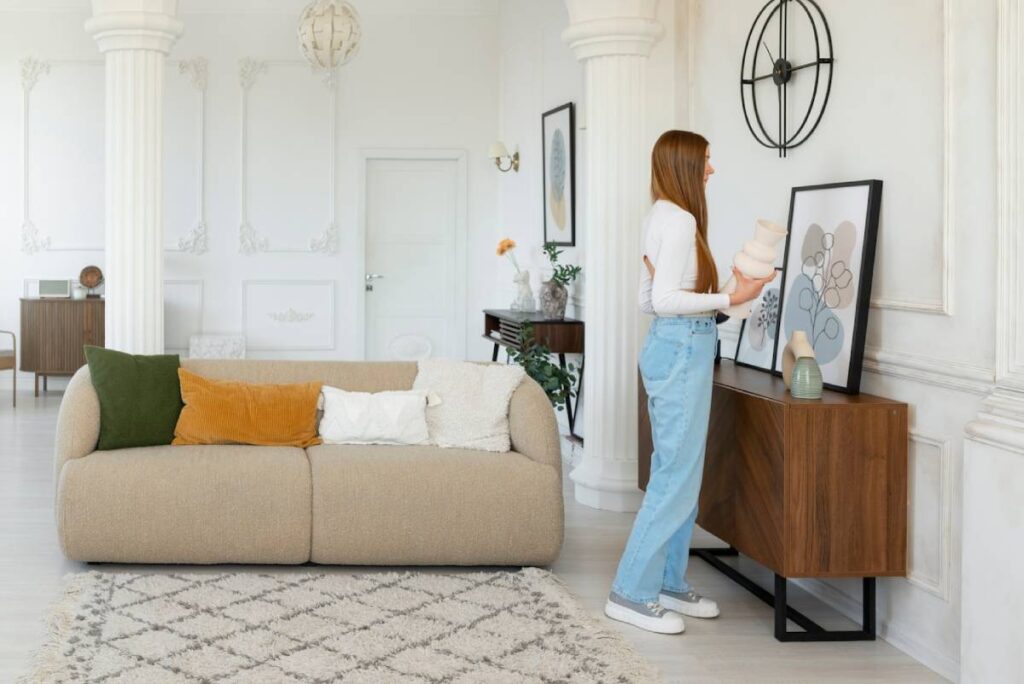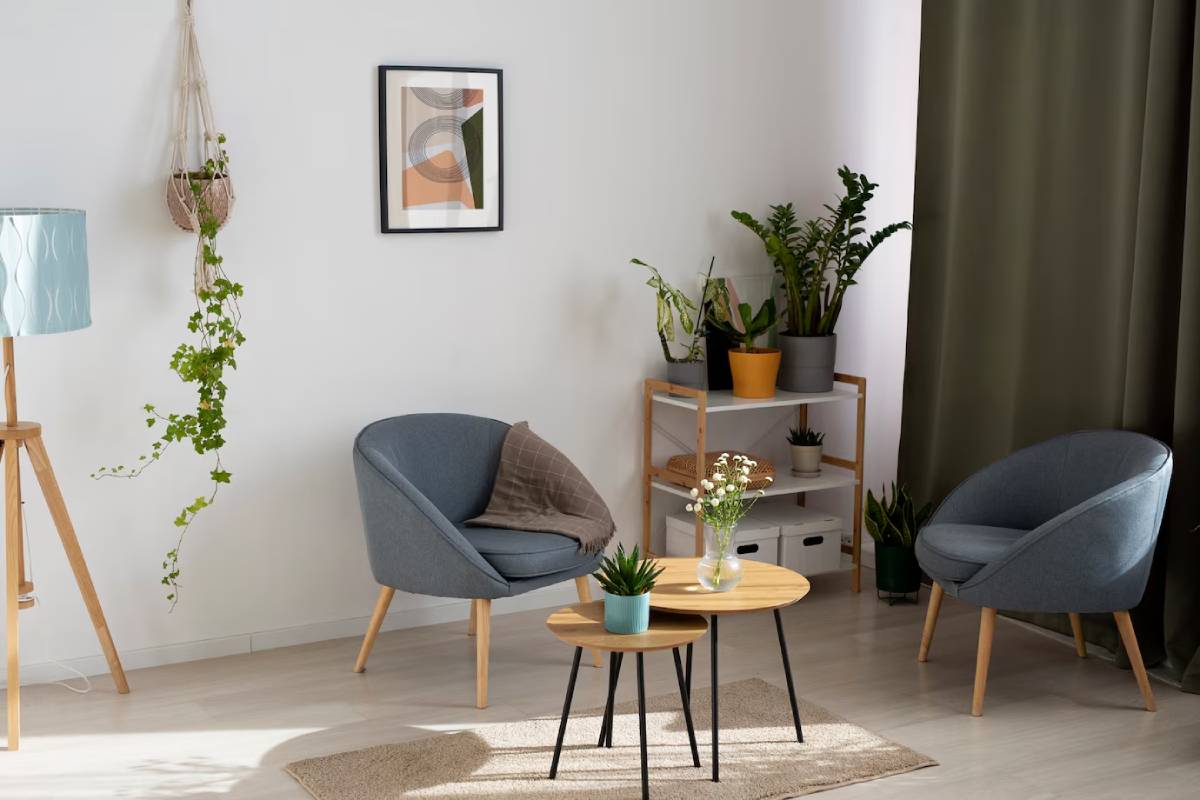The Interior Design Blog

Minimalist Decor on a Budget: Less is More
Minimalism isn’t about owning nothing—it’s about surrounding yourself with intention. It celebrates clean lines, negative space, and the beauty of simplicity. But achieving that effortless look can sometimes feel… expensive. Fortunately, minimalist interiors don’t require high-end labels or designer pieces. With the right approach, affordable minimalist decor is well within reach.
In this guide, we explore how to create serene, uncluttered spaces without stretching your budget. From smart sourcing to styling strategies, these frugal decorating tips will help you curate a minimalist home that looks polished—without costing a fortune.
Why Minimalism Appeals—Especially on a Budget

Minimalism thrives on the idea that less is more. This philosophy naturally aligns with conscious spending and budget home styling.
Here’s why it works so well for cost-conscious decorators:
- Fewer items = less spending
- Neutral, timeless pieces = long-term value
- Focus on function = intentional investments
- Less visual clutter = more mental clarity
When done right, minimalist spaces don’t just look good—they feel good. They support calm, routine, and creativity, all while asking less of your wallet.
Core Principles of Budget Minimalist Decor
1. Function Comes First
Minimalist design puts practicality above ornament. Instead of filling space for the sake of it, each piece should serve a purpose—whether functional, aesthetic, or both. That mindset naturally limits impulse purchases and keeps your budget focused.
2. Quality Over Quantity
Instead of buying multiple cheaper items, opt for one well-made piece that will last. This may mean saving for a better sofa or refinishing a second-hand table rather than buying new one.
3. Neutral Tones, Layered Textures
Stick to a palette of whites, greys, beige, or earth tones to keep things calm and cohesive. Add dimension through textiles like linen, cotton, jute, and wood rather than through bold colour.
Affordable Minimalist Decor Ideas That Work
Minimalism doesn’t mean stark. It means thoughtful. These ideas are affordable, adaptable, and proven to elevate any room.
Embrace Negative Space
Let blank walls and empty corners be part of the design. Space is a visual luxury—and it costs nothing. Avoid over-decorating and allow the eye to rest.
Thrift and Repurpose with Purpose
Minimalism isn’t about newness—it’s about intentionality. Thrift stores, estate sales, and buy-nothing groups are rich sources of potential minimalist gems.
Smart thrift finds:
- Simple ceramic vases
- Mid-century side tables
- Clean-lined shelving units
- Neutral-toned rugs or curtains
With a little imagination, pre-loved pieces can be sanded, painted, or styled to feel fresh and modern.
Focus on the Statement Lighting
Lighting does more than illuminate—it shapes mood. Choose simple pendant lights, sculptural lamps, or budget-friendly LED sconces in clean finishes like matte black or brushed brass.
Many budget retailers offer minimalist lighting options that mimic high-end design, especially when styled alongside muted surroundings.
Opt for Open Shelving (Sparingly)
Replace bulky bookcases with floating shelves. Display only the essentials—neutral ceramics, greenery, or stacked books with toned-down covers.
Open shelves force curation and reduce overaccumulation. They’re also significantly cheaper than enclosed storage pieces.
Stick to a Simple Art Style
Framed prints, black-and-white photography, or line drawings add elegance without clutter. For an ultra-frugal route, explore:
- Free printable art from online archives
- DIY abstract pieces using paint samples
- Framing pages from neutral-toned design magazines
Uniform frames in black, white, or natural wood help tie everything together.
Layer Textiles Thoughtfully
Even the most pared-back space needs softness. Use a few well-placed textiles to bring warmth without visual chaos.
Affordable additions include:

- Neutral cushion covers in linen or canvas
- A flatwoven rug in jute or wool blends
- A cotton throw casually draped over a bench or sofa
Stick to low-contrast textures for cohesion and longevity.
Frugal Decorating Tips: Spend Less, Style More
Shop Slow
Wait before buying. Living in your space allows you to see what you actually need—not just what would fill a blank spot.
Borrow Before Buying
Need a side chair for occasional use? Try borrowing from another room before making a purchase.
Use What You Have
Rearranging furniture or restyling shelves can offer a refresh without buying anything new.
Paint Instead of Replace
A fresh coat of matte paint in a neutral tone can turn mismatched furniture into a harmonious set.
DIY the Details
Candleholders, plant stands, abstract art, and fabric accents are all great DIY targets. Minimalism thrives on clean lines—perfect for beginner projects.
Budget-Friendly Room-by-Room Styling Ideas
Living Room
- A neutral rug, a single sculptural coffee table, and 2–3 matching cushions
- One large piece of art or a mirror as a statement
- Sheer curtains for soft light and openness
Bedroom
- A low-profile bed frame, white or beige linens, and a single throw pillow
- A simple bedside table with a reading light and plant
- Neutral wall colour with one framed art piece or wall hook feature
Kitchen
- Clear countertops with only essentials on display
- Open shelves with matching jars or crockery
- Swap dated knobs for matte black or brushed brass hardware
Bathroom
- A muted shower curtain and simple soap dispensers
- Rolled towels in one colour palette
- A single piece of wall art or greenery for softness
Styling with Intention
Minimalism isn’t about emptying your home—it’s about editing. Whether you’re decorating from scratch or refining what you already have, approach each item with one question: Does this add value—visual, functional, or emotional?
If not, it might be worth letting go or finding a more fitting alternative. Even within budget home styling, intentionality always yields better results than excess.
Final Thoughts: Simplify with Style
Minimalism doesn’t demand perfection or pricey pieces. It invites you to be more present in your space and thoughtful with what fills it. Through affordable minimalist decor, you can create a home that reflects calm, clarity, and care—without breaking the bank.
By choosing well, buying less, and styling with purpose, your home becomes not just a place to live—but a reflection of what you truly value.









